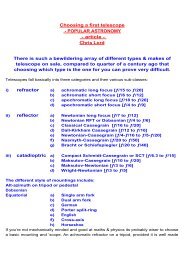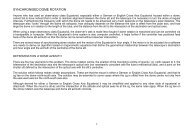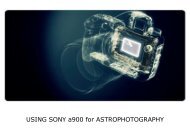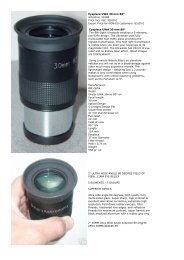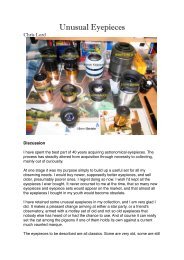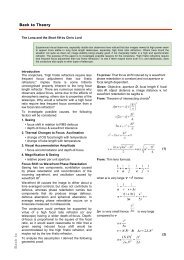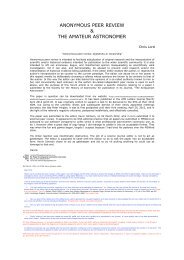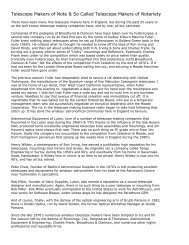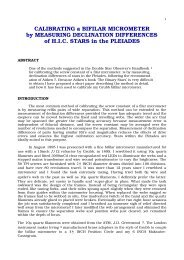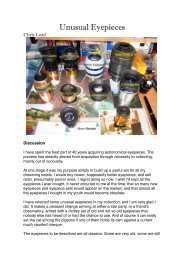Evolution of the Astronomical Eyepiece - Brayebrook Observatory
Evolution of the Astronomical Eyepiece - Brayebrook Observatory
Evolution of the Astronomical Eyepiece - Brayebrook Observatory
Create successful ePaper yourself
Turn your PDF publications into a flip-book with our unique Google optimized e-Paper software.
ORTHOSCOPIC EYEPIECES:<br />
EVOLUTION <strong>of</strong> <strong>the</strong> ASTRONOMICAL EYEPIECE<br />
The quest for distortionless imaging<br />
characteristics <strong>of</strong> photographic objectives<br />
in <strong>the</strong> 1850’s and 1860’s led C.A.<br />
Steinheil to design <strong>the</strong> Periscop lens in<br />
1865. Prior to this in 1859 <strong>the</strong> Petzval<br />
Orthoskop appeared. The fundamental<br />
property <strong>of</strong> any orthopscopic lens is<br />
that it should have a wide flat field free<br />
from rectilinear distortion and angular<br />
magnification distortion.<br />
to 40˚ at f/5. In <strong>the</strong> mid-1930’s Barr<br />
and Stroud patented an orthoscopic<br />
eyepiece in which <strong>the</strong> simple eye lens is<br />
bi-convex, with <strong>the</strong> steeper convex surface<br />
remote from <strong>the</strong> eye having a parabolic<br />
figure. This widened <strong>the</strong> distortion<br />
free field to 64˚ and <strong>the</strong> eye clearance<br />
was extended to 0.91Fe. Th e<br />
glasses used were boro-silicate crown<br />
and extra-dense flint.<br />
In 1880 Ernst Abbé brought out an<br />
Ortho scopic eyepiece for Zeiss. The<br />
field lens is an overcorrected triplet<br />
combination with a negative component<br />
in <strong>the</strong> middle, followed by a simple<br />
plano-convex eye lens, convex surface<br />
almost in conta ct. This eyepiece is<br />
remarkable for great eye clearance and<br />
has given rise to a whole family <strong>of</strong> eyepieces,<br />
some <strong>of</strong> <strong>the</strong>m <strong>of</strong> very complex<br />
for m. In Abbé’s design hard crown and<br />
dense flint glasses were used to secure<br />
an apparent field <strong>of</strong> 30˚, and an eye<br />
cleara nce <strong>of</strong> 0.8Fe. The Zei ss<br />
Orthoscopic patented in 1930 made<br />
use <strong>of</strong> less u sual gla sses; barium<br />
c rown, extra -dense flint an d borate<br />
flint. This increased <strong>the</strong> apparent field<br />
Ano<strong>the</strong>r aspheric variant was designed<br />
for Zeiss, probably by Robert Richter in<br />
1934.<br />
A c c o rdi ng to th e Briti sh paten t, <strong>the</strong><br />
t h i rd surf ace ( a steeply con ve x fa ce<br />
<strong>of</strong> an over- c o r rect ed eye triplet) wa s<br />
p ara boliz ed and pro vi ded a w idean<br />
gle eyepiece w ith a 53˚ field in<br />
w hi ch distorti on wa s eliminated; <strong>the</strong><br />
l ateral colou r removed w itho ut use<br />
bein g ma de <strong>of</strong> mo re than o ne lens <strong>of</strong><br />
flint gla ss; a st igmatism reduced t o<br />
t hat resu lti ng f rom <strong>the</strong> Pe tzval curv<br />
a t u re, a nd spherical aberration o f<br />
<strong>the</strong> exi t pu pil el iminat ed or marg i n-<br />
all y reve rsed. Eye c leara nce w as<br />
reduced sligh tly to 0. 66Fe.<br />
26



